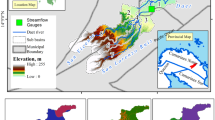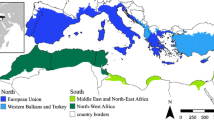Abstract
Efficient water allocation for sustainable irrigated agriculture has become a growing concern, especially in transboundary river basins where the competition between upstream and downstream countries is substantially increasing. In this paper, the Diyala basin, one of the most water-stressed basins shared between Iraq and Iran, was used as an example case study. The water-stress situation is projected to get worse in the foreseeable future, as climate change adversely altered runoff at a time when demand for water is witnessing remarkable growth. Irrigated agriculture is the greatest consumer of the water supply, having a critical role for the efficiency of water use. The study aims at examining the sensitivity of irrigation demands to a set of potential improvements in irrigation efficiency (between 40 % and 60 %) in the riparian countries under different operational conditions. The investigation of the climate trends discloses that the area tends to be drier, with lower precipitation and higher rates of potential evapotranspiration. The possible impacts of climate change on water availability were examined through the simulation of various climatic scenarios with a rainfall-runoff model. Results show that the annual runoff may be reduced from 14 % to 30 %. It is estimated that such reduction can cause considerable water deficits, especially when there are small improvements in irrigation efficiency. This approach can support the development of a set of plausible scenarios to reduce irrigation water demand while maintaining a healthy agricultural sector.







Similar content being viewed by others
References
Al-Faraj FAM, Al-Dabbagh BNS (2015) Assessment of collective impact of upstream watershed development and basin-wide successive droughts on downstream flow regime: the Lesser Zab transboundary basin. J Hydrol 530:419–430
Al-Faraj FA, Scholz M (2014a) Assessment of temporal hydrologic anomalies coupled with drought impact for a transboundary river flow regime: the Diyala watershed case study. J Hydrol 517:64–73
Al-Faraj FA, Scholz M (2014b) Incorporation of the flow duration curve method within digital filtering algorithms to estimate the base flow contribution to total runoff. Water Resour Manag 28(15):5477–5489
Al-Faraj FA, Scholz M (2015) Impact of upstream anthropogenic river regulation on downstream water availability in transboundary river watersheds. Int J Water Resour Dev 31(1):28–49
Al-Faraj FA, Scholz M, Tigkas D (2014) Sensitivity of surface runoff to drought and climate change: application for shared river basins. Water 6(10):3033–3048
Al-Faraj F, Tigkas D, Scholz M (2015a) Sensitivity of irrigation requirements to improvement in irrigation efficiency in climate-induced changes: example of a transboundary watershed. The 9th World Congress of the European Water Resources Association (EWRA), Istanbul
Al-Faraj FA, Scholz M, Tigkas D, Boni M (2015b) Drought indices supporting drought management in transboundary watersheds subject to climate alterations. Water Policy 17(5):865–886
Ali MK, Klein KK (2014) Water use efficiency and productivity of the irrigation districts in Southern Alberta. Water Resour Manag 28(10):2751–2766
Allen R, Pereira LS, Raes D et al. (1998) Crop evapotranspiration – guidelines for computing crop water requirements. FAO Irrigation and Drainage Paper No 56, Rome
Bogawski P, Bednorz E (2014) Comparison and validation of selected evapotranspiration models for conditions in Poland (Central Europe). Water Resour Manag 28(14):5021–5038
Dahal V, Shakya NM, Bhattarai R (2016) Estimating the impact of climate change on water availability in Bagmati Basin, Nepal. Environ Process 3(1):1–17
Debnath S, Adamala S, Raghuwanshi NS (2015) Sensitivity analysis of FAO-56 Penman-Monteith method for different agro-ecological regions of India. Environ Process 2(4):689–704
Dile YT, Srinivasan R (2014) Evaluation of CFSR climate data for hydrologic prediction in data-scarce watersheds: an application in the Blue Nile River Basin. J Am Water Resour Assoc (JAWRA) 50(5):1226–1241
.Duan Q, Sorooshian S, Gupta V (1992) Effective and efficient global optimization for conceptual rainfall-runoff models. Water Resour Res 28(4):1015–1031
FAO (2011) Food and Agriculture Organization of the United Nations. climate change, water and food security. Report No. 36. http://www.fao.org/docrep/014/i2096e/i2096e.pdf
FAO (2012) Food and Agriculture Organization of the United Nations. Aquastat database. http://www.fao.org/nr/water/aquastat/countries_regions/AFG/index.stm. Accessed 26 December, 2014
FAO (2014) Food and Agriculture Organization of the United Nations. Aquastat database. http://www.fao.org/nr/water/aquastat/data/query/index.html?lang=en%E2%80%A6. Accessed 23 October 2014
Fischer G, Tubiello FN, van Velthuizen H, Wiberg DA (2007) Climate change impacts on irrigation water requirements: effects of mitigation, 1990-2080. Technol Forecast Soc Chang 74:1083–1107
Foley JA, Ramankutty N, Brauman KA, Cassidy ES, Gerber JS, Johnston M et al (2011) Solutions for a cultivated planet. Nature 478(7369):337–342
Fuka DR, Walter MT, MacAllister C, Degaetano AT, Steenhuis TS, Easton ZM (2014) Using the climate forecast system reanalysis as weather input data for watershed models. Hydrol Process 28(22):5613–5623
Goudie AS (2013) The human impact on the natural environment: past, present, and future, 7th edn. Wiley, Chichester
IPCC (2014) Climate change 2014: impacts, adaptation, and vulnerability. part A: global and sectoral aspects. contribution of working group II to the Fifth assessment report of IPCC, field CB et al. Cambridge University Press, Cambridge
Jury WA, Vaux HJ (2007) The emerging global water crisis: managing scarcity and conflict between water users. Adv Agron 95:1–76
Keshavarz A, Heydari N, Ashrafi S et al. (2003) Management of agricultural water consumption, drought and supply of water for future demands. Paper presented at the Seventh International Conference on the Development of Dry Land, 14–17 September, Tehran, Iran
Knox JW, Kay MG, Weatherhead EK (2012) Water regulation, crop production and agricultural water management − understanding farmer perspectives on irrigation efficiency. Agric Water Manag 108:3–8
Kwon H, Choi M (2011) Error assessment of climate variables for FAO-56 reference evapotranspiration. Meteorog Atmos Phys 112(1-2):81–90
Millennium Ecosystem Assessment (2005) Ecosystems and human well-being: synthesis. Island Press, Washington, DC, http://www.millenniumassessment.org/documents/document.356.aspx.pdf
Nikkami D (2009) A country report of irrigation efficiency in Iran. Presented at the workshop on improving agricultural productivity, water use efficiency & strengthening rural livelihoods, 28–30 January, 2009, Bangkok, Thailand
Núñez M, Pfister S, Antón A, Muñoz P, Hellweg S, Koehler A, Rieradevall J (2013) Assessing the environmental impact of water consumption by energy crops grown in Spain. J Ind Ecol 17(1):90–102
Pereira LS (2004) Trends for irrigated agriculture in the Mediterranean region: coping with water scarcity. Europ Water 7–8:47–64
Peter JR (2004) Participatory irrigation management, international network on participatory irrigation management. Washington, DC: INWEPF/SY/2004(06). http://www.maff.go.jp/e/nousin/kaigai/inwepf/i_document/pdf/sympo_inpim.pdf
Pfister S, Bayer P, Koehler A, Hellweg S (2011) Environmental impacts of water use in global crop production: hotspots and trade-offs with land use. Environ Sci Technol 45(13):5761–5768
Rasouliazar S (2011) A study of factors influencing development of pressurized irrigation systems in Iran (case study in West Azerbaijan province). American-Eurasian J Agric Environ Sci 10(5):928–933
Seckler D, Barker R, Amarasinghe U (1999) Water scarcity in the twenty-first century. Water Resour Dev 15:29–42
Sharifi A, Dinpashoh Y (2014) Sensitivity analysis of the Penman-Monteith reference crop evapotranspiration to climatic variables in Iran. Water Resour Manag 28(15):5465–5476
Tabari H, Talaee PH (2011) Local calibration of the Hargreaves and Priestley-Taylor equations for estimating reference evapotranspiration in arid and cold climates of Iran based on the Penman-Monteith model. J Hydrol Eng 16(10):837–845
Tigkas D, Tsakiris G (2004) Medbasin: A Mediterranean rainfall—runoff software package. European Water 5–6:3–11
Tigkas D, Tsakiris G (2015) Early estimation of drought impacts on rainfed wheat yield in Mediterranean climate. Environ Process 2(1):97–114
Tigkas D, Vangelis H, Tsakiris G (2012) Drought and climatic change impact on streamflow in small watersheds. Sci Total Environ 440:33–41
Tigkas D, Vangelis H, Tsakiris G (2013) The RDI as a composite climatic index. Europ Water 41:17–22
Tigkas D, Vangelis H, Tsakiris G (2015) DrinC: a software for drought analysis based on drought indices. Earth Sci Inform 8(3):697–709
Tigkas D, Christelis V, Tsakiris G (2016) Comparative study of evolutionary algorithms for the automatic calibration of the Medbasin-D conceptual hydrological model. Environ Process. doi:10.1007/s40710-016-0147-1
Tsakiris G, Pangalou D, Vangelis H (2007) Regional drought assessment based on the Reconnaissance Drought Index (RDI). Water Resour Manag 21(5):821–833
Turral H, Svendsen M, Faures JM (2010) Investing in irrigation: reviewing the past and looking to the future. Agric Water Manag 97:551–560
UN-WWDR (2014) The United Nations World Water Development Report. Water Energ 1. http://unesdoc.unesco.org/images/0022/002257/225741e.pdf
USAID (2004) United States Agency for International Development. agriculture reconstruction and development programme for Iraq: irrigation water management assessment and priorities for Iraq. http://pdf.usaid.gov/pdf_docs/Pnadi054.pdf
Vangelis H, Tigkas D, Tsakiris G (2013) The effect of PET method on Reconnaissance Drought Index (RDI) calculation. J Arid Environ 88:130–140
World Bank-FAO (2011) The World bank-Food and Agriculture Organization of the UN. Iraq sector note. http://www.fao.org/fileadmin/user_upload/rust/docs/CH3_IRAQ_web.pdf
Yilmaz B, Yurdusev MA, Harmancioglu NB (2009) The assessment of irrigation efficiency in Buyuk Menderes Basin. Water Resour Manag 23(6):1081–1095
Zubari WK (2002) Alternative water resources management policies in West Asia. Industry Environ 25(1):43–47, http://www.waleedzubari.com/wp-content/uploads/2012/10/UNEP_Industry-and-Environment_vol25no1.pdf
Acknowledgments
An initial version of this paper has been presented at the 9th World Congress of the European Water Resources Association (EWRA) “Water Resources Management in a Changing World: Challenges and Opportunities”, Istanbul, Turkey, June 10–13, 2015.
Author information
Authors and Affiliations
Corresponding author
Rights and permissions
About this article
Cite this article
Al-Faraj, F.A.M., Tigkas, D. & Scholz, M. Irrigation Efficiency Improvement for Sustainable Agriculture in Changing Climate: A Transboundary Watershed Between Iraq and Iran. Environ. Process. 3, 603–616 (2016). https://doi.org/10.1007/s40710-016-0148-0
Received:
Accepted:
Published:
Issue Date:
DOI: https://doi.org/10.1007/s40710-016-0148-0




